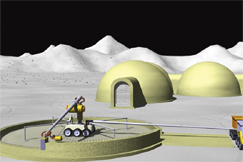
November 2021
Dear EarthTalk: Is so-called “Off-Earth Manufacturing” really the environmental panacea that Jeff Bezos and other proponents say it is? ~ M. Traney, Smithfield, RI
In July 2021, Richard Branson rocketed into suborbital space aboard a craft he helped fund, launching a new era of commercial space travel. Branson’s Virgin Galactic rocket emitted plumes of white smoke and tons of kerosene, releasing more greenhouse gases in a few minutes than a typical car would over two centuries. It also emitted black carbon—or soot—into upper layers of the atmosphere, contaminating the air for years to come.
Space companies counter environmental concerns about space flight with promises to construct greener spacecrafts and to transform space into the newest global economic powerhouse. “We need to take all heavy industry, all polluting industry, and move it into space and keep Earth as this beautiful gem of a planet that it is,” said Blue Origin founder Jeff Bezos after returning from his own first trip into orbit a few weeks following Branson. Bezos’s vision, otherwise known as “Off-Earth manufacturing,” centers around the transition of planet-exploitative industries into space.

Many materials extracted on Earth are also available in space. Celestial bodies like asteroids and the Moon contain water and water-derived propellants that can be used for in-space infrastructure. With the global mining industry tumbling from a market value of over $1.6 trillion in 2010 to $656 billion in 2020, space resources appear as realistic alternatives for mining. A report by Goldman Sachs, asteroid mining has costs “comparable to traditional mines.”
“Off-Earth manufacturing” does drive energy and mining industries away from exploiting the finite resources on Earth, but the construction of such complex systems in space poses many challenges. Apart from the huge expense of launching materials into space, architects familiar with normal conventions of physics will be forced into a foreign field of designing for zero-gravity spaces. Additionally, large amounts of materials need to be produced and transported that are incredibly durable, able to withstand extreme temperatures, and that transmit information without loss.
The road to space commercialization is long and arduous, but the launching of SpaceX and Blue Origin rockets is a key stepping stone. As expenses of space travel continue to decrease, interest and investments in the global space industry will only increase. Bezos has already announced he is spending $1 billion every year on Blue Origin. Venture capital firms are pouring money into space startups. According to recent data from Space Capital, almost $38 billion has gone to space infrastructure companies over the past decade. On a wider scale, the global space industry is expected to generate over $1.1 trillion by 2040 in a report by Morgan Stanley, up from the $447 billion in a 2020 report by the Space Foundation.
Will time tell if Off-Earth manufacturing can help ease environmental pressures down here on our own planet? One has to wonder why we are so concerned with moving our polluting industries off-planet when we could concentrate instead on cleaning them up down here or eliminating them entirely.
CONTACTS: “Can we get to space without damaging the Earth through huge carbon emissions?” latimes.com/business/story/2020-01-30/space-launch-carbon-emissions; “Why big business is making a giant leap into space,” knowledge.wharton.upenn.edu/article/commercial-space-economy; Making Stuff in Space: Off-Earth Manufacturing is Just Getting Started, space.com/40552-space-based-manufacturing-just-getting-started.html.
Dear EarthTalk: Is it true that we’ve done such a good job bringing back bald eagles that they’ve become pests now? ~ D. Maguire, Winston-Salem, NC
It’s hard to believe the bald eagle was on the brink of extinction in the Lower 48 United States just a half century ago, given how common the majestic birds are all over the country nowadays. While their population rebound is indeed a great source of pride for the environmental movement, some American farmers are wondering if maybe we have too much of a good thing, given a recent uptick of eagles’ preying on livestock.

While bald eagle populations fell drastically in the first half of the 20th century mostly due to hunting, it wasn’t until the 1960s that people started to realize how big a threat the insecticide DDT was to supporting healthy eagle populations. The synthetic chemical was successful in keeping insects down. But when eagles ingested the chemical, it made their egg shells fragile and prone to cracking prematurely, dooming the chick inside to a premature death. Rachel Carson’s landmark 1962 book Silent Spring highlighted the plight of eagles and other birds as victims of DDT poisoning.
In 1963, there were just 417 known mating pairs of bald eagles within the U.S. In 1972, the federal government banned DDT, and eagle populations started to rebound within a few years, with no looking back. By 2017, researchers believe 70,000 bald eagles inhabited the Lower 48; a 2021 survey estimates that number has now grown to over 300,000 individual bald eagles.
This exponential growth has sparked a call for officials to reconsider protection for the species. The presence of too many bald eagles has been a problem for decades in Alaska, where the birds were able to hold on better than in the Lower 48. In 1917, bald eagles were causing so many issues for the Alaskan fishing industry that the government placed a bounty on the birds. An editorial in 1920 from Douglas Island News in Alaska stated that: “Sentimentally, [the bald eagle] is a beautiful thing, but in life it is a destroyer of food and should be and is killed wherever found.”
Similar situations could start to become more common in the Lower 48, where bald eagles have grown so much in population that they pose a significant threat to farms and pastures where chickens, ducks and other animals roam. Farmers don’t know what to do about it, though, as shooting a bald eagle is a $100,000 fine along with a year of jail time.
One option for farmers is to get an “eagle-depredation” permit from the U.S. Fish and Wildlife Service if the birds have become “injurious to wildlife, agriculture or other personal property, or human health and safety.” Once granted, non-lethal deterrents like air horns, scarecrows and pyrotechnics can be used to scare them off, though farmers have little recourse if these tactics fail. In the end, we’re just going to have to get used to having so many of these majestic creatures around, reminding us not only of our freedom and national pride but also of what good stewards we can be for nature when we set our hearts and minds to it.
CONTACTS: “History of Bald Eagle Decline, Protection and Recovery,” fws.gov/midwest/eagle/history/index.html; “When The National Bird Is A Burden,” nytimes.com/2017/01/19/magazine/bald-eagle-national-burden.html.
Dear EarthTalk: What are the main contaminants we have to worry about in our drinking water? How can we know if we are being exposed and what can we do about it? ~ L. Minto, Bern, NC
Today, most Americans get their water from their sinks or fridge filters, and it travels great distances to get there. On the way, it may pick up chemicals that are harmful to our health if not filtered out properly.
An analysis by the non-profit Natural Resources Defense Council (NRDC) using 2016 data from the U.S. Environmental Protection Agency (EPA) found that some 18 million Americans were living in areas with unsafe levels of lead in the water. In another report, USA Today found that 63 million Americans were exposed to unsafe drinking water from 2007-2017. Water pollution issues were also found to disproportionately plague minority and low-income communities.

Flint, Michigan has been a leading example of U.U. communities facing water pollution. Discolored and highly polluted water was piped into Flint for 18 months during which time residents experienced skin rashes, itchy skin and hair loss. Although complaints were filed by Flint community members, they were dismissed by government officials. Many felt the government’s response (or lack thereof) was rooted in prejudice as the majority of Flint’s population is black and two of five residents live below the poverty line. Michigan’s own Civil Rights Commission called the poor response a “result of systemic racism.”
One of the main poisons in Flint’s water was lead, which entered the water via corroded plumbing. The Centers for Disease Control & Prevention (CDC), says that lead exposure is especially harmful to kids, causing brain and nervous system damage, developmental, learning and behavioral issues and hearing loss. In adults, lead can cause high blood pressure, miscarriage, infertility and brain and kidney damage.
Some other common contaminants in drinking water are perfluorooctanesulfonic (PFOS) and perfluorooctane (PFOA), strontium and perchlorate. PFOS and PFOA are persistent man-made chemicals that can seep into groundwater sources and don’t break down easily. They’ve been linked to chronic kidney disease and several forms of cancer. Strontium can weaken bones and stunt bone growth. Florida, Texas and Eastern Wisconsin each have higher than normal percentages of strontium in their water because many reservoirs come from carbonate rock aquifers in these states. Perchlorate disrupts the thyroid’s ability to produce hormones. It has also been labeled a “likely human carcinogen” by the EPA. It is estimated that 11 million Americans live in areas with perchlorate concentrations that are higher than what is considered safe in drinking water.
If you’d like to know what’s in your drinking water, look online for free local water testing reports, or find a lab that will test your home water supply for between $20-100. Advocating for clean water to local, state and federal government agencies is also key to maintaining the community’s right to clean water.
CONTACTS: Basic Information about Lead in Drinking Water, epa.gov/ground-water-and-drinking-water/basic-information-about-lead-drinking-water; More than 2 million Americans exposed to high levels of strontium in drinking water, ehn.org/strontium-in-drinking-water-2651752809/removal-of-strontium-from-drinking-water; Perchlorate in Drinking Water, emagazine.com/perchlorate-in-drinking-water/; Flint Water Crisis: Everything You Need to Know, nrdc.org/stories/flint-water-crisis-everything-you-need-know.
EarthTalk® is produced by Roddy Scheer & Doug Moss for the 501(c)3 EarthTalk.
See more at https://emagazine.com. To donate, visit https://earthtalk.org.
Send questions to: question@earthtalk.org

